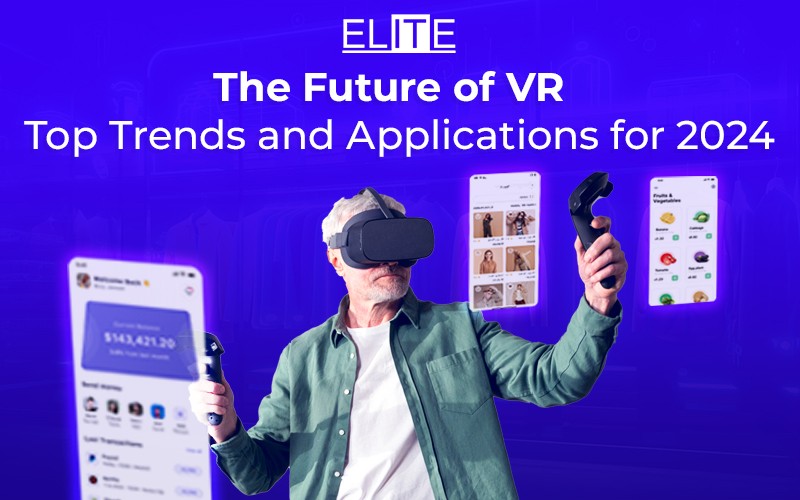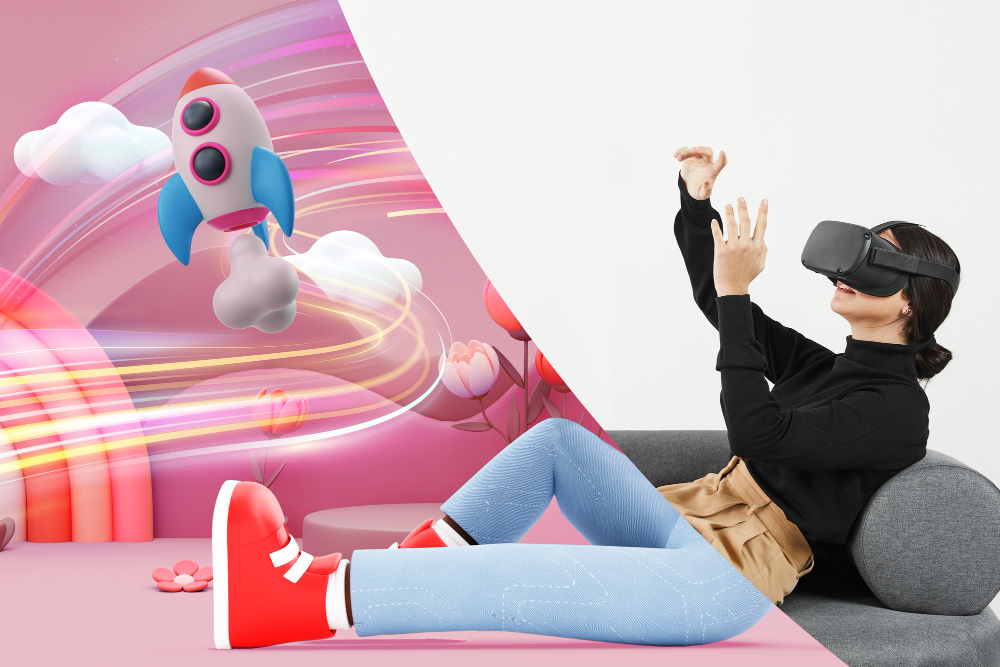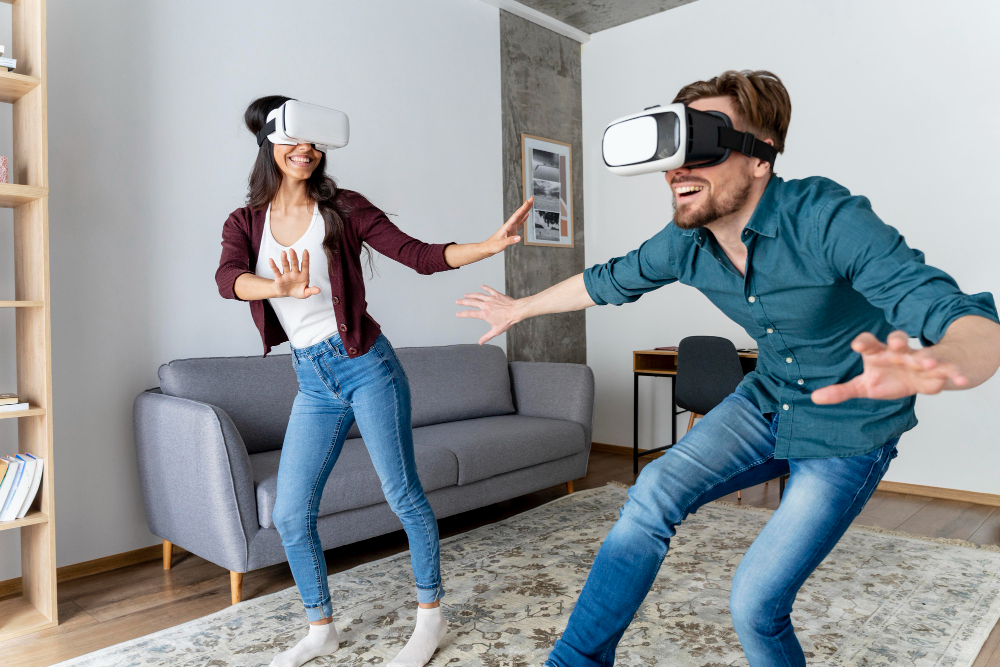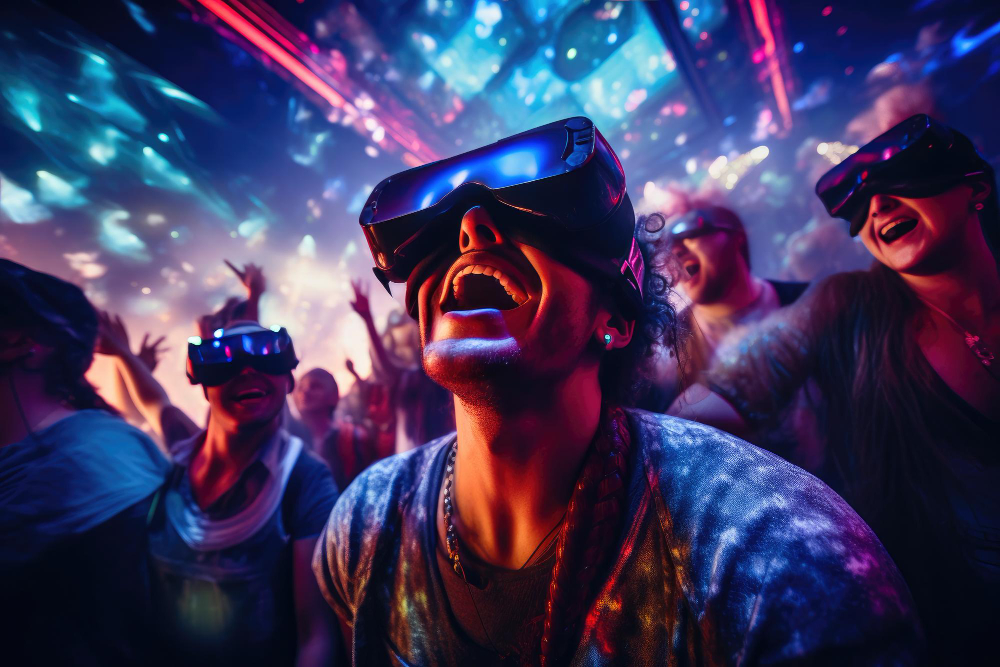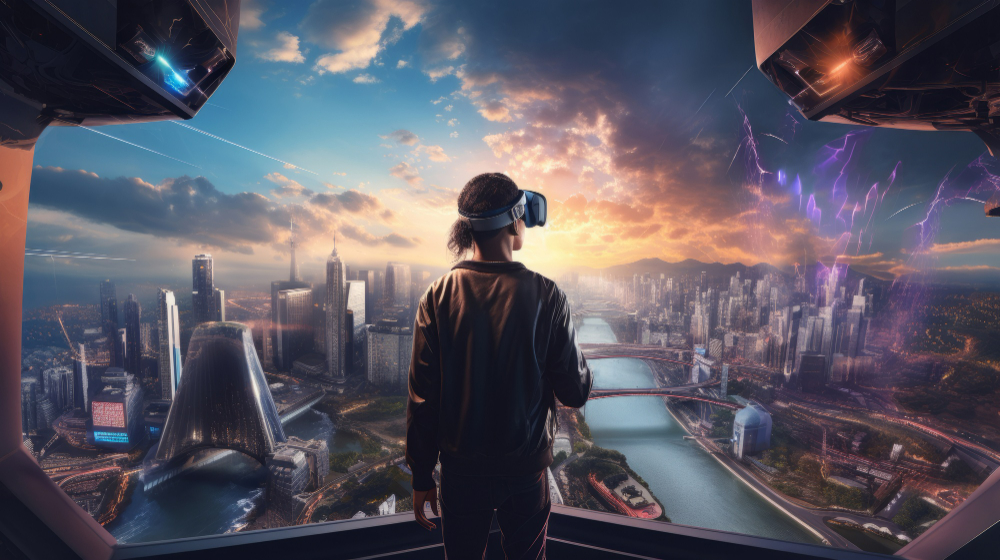For decades, Virtual Reality (VR) has captivated our imaginations, often depicted in movies as a fantastical escape into entirely new worlds. VR development services are at the forefront of shaping the future of VR, crafting immersive experiences that transcend simple visuals and trick our senses into believing we’re truly present within computer-generated environments.
The VR market is experiencing explosive growth, with millions of headsets finding their way into homes in 2023 alone. Analysts predict this is just the beginning, with advancements in technology and a wider range of accessible and affordable VR experiences fueling exponential growth in the coming years. Leading IT service providers are also playing a crucial role in advancing VR technology, ensuring robust infrastructure and seamless integration with other digital solutions.
This blog dives deep into the top VR trends and applications, offering a glimpse into the exciting possibilities that lie ahead in 2024 and beyond. We’ll also explore where will Virtual Reality take us and Is Virtual Reality the future?
The Future of VR: Key Trends for 2024
The future of VR is brimming with exciting possibilities, promising to revolutionize various aspects of our lives. Buckle up as we explore the key trends shaping the future of the Virtual Reality landscape in 2024 and beyond.
Step Into Immersive Educational Experiences with VR:
What is the future of Virtual Reality in education? In 2024, VR will take education to new heights, shattering traditional boundaries. Imagine classrooms transported to historical periods or distant planets, bringing history, geography, and science to life through engaging, interactive VR experiences.
Medical training receives a revolutionary boost, allowing students to practice complex procedures in a risk-free virtual environment. Future applications of Virtual Reality in education are poised to reshape the entire approach to learning and training.
Exploring the Dawn of Hyper-Realistic Virtual Reality:
Get ready for a future of Virtual Reality where the line between virtual and real life blurs. Future of Virtual Reality technology like hyper-realism, a major 2024 VR trend, pushes the boundaries of immersion by incorporating real-world physical sensations. Imagine feeling raindrops on your skin, smelling a virtual meadow, or even tasting food in a simulated feast. As virtual reality trends continue to evolve. This sensory VR creates an experience so real, it might be hard to distinguish from the actual world hence its been rightly said that Virtual Reality is the future.
The Evolution of Social VR Platforms:
The rise of social VR platforms is a game-changer, allowing real-time interaction within virtual environments. Users can host parties, attend virtual concerts, or team up in multiplayer games. These platforms are becoming increasingly user-friendly, diverse, and community-focused, fostering a more connected and social future of virtual reality.
VR’s Adoption in the Business Realm:
The VR revolution extends beyond entertainment, impacting various aspects of the business world. From prototyping and design to staff training and customer service, companies are leveraging VR’s versatility. As the technology becomes more affordable and accessible, we can expect even broader adoption, highlighting the growing importance of the future of virtual reality technology in business trends.
Apple’s Vision Pro Redefining Virtual Reality:
The Apple Vision Pro marks a significant shift in the future of VR technology. It boasts high-resolution displays and a user-centric design for unparalleled immersion. Ergonomic comfort and interactive AR overlays broaden its application in education, gaming, and professional simulations. Enhanced connectivity seamlessly integrates with existing Apple ecosystems, setting a new standard for VR engagement and interactivity.
Challenges and Ethical Considerations in VR:
As VR technology progresses, addressing ethical concerns and data security issues becomes critical. With immersive environments gathering vast amounts of personal data, risks like data breaches and misuse of sensitive information are on the rise. Developers must establish strong data handling protocols to safeguard user information, ensuring that personal and behavioral data collected during VR experiences remain secure. Enhanced data security practices, including robust encryption methods, can help prevent unauthorized access and reinforce user trust in the technology.
Beyond technical challenges, there are ethical considerations regarding the psychological impact of VR. Extended immersion may lead to concerns such as social isolation and even altered perceptions of reality, raising questions about the boundaries between virtual and physical worlds. Additionally, user privacy remains a priority, as VR platforms must navigate how they collect and use personal data responsibly. Balancing technological advancement with these ethical considerations is essential to build a sustainable future for VR, ensuring that users can engage with this exciting technology while remaining protected and aware of its broader impacts.
What are the Potential Future Uses of Virtual Reality and Who It Benefits?
VR’s potential extends far and wide, transforming various fields. Just like any other thing, there are pros and cons of virtual reality but the advantages outweigh the disadvantages as we embrace VR’s promising future. Let’s explore the exciting possibilities and see who benefits VR in the future.
A Smooth Blending of the Virtual and Real Worlds:
Virtual reality technology is poised to seamlessly blend the virtual and real worlds, creating experiences that feel increasingly authentic. Imagine exploring virtual museums while feeling the cool stone floor beneath your feet or attending virtual concerts with the pulse of the music vibrating through your body. This blurring of lines will revolutionize how we interact with the digital world, and as part of virtual reality future predictions, such advancements will continue to transform industries like education, entertainment, and communication.
Widespread Use Across a Range of Industries:
VR’s applications extend far beyond entertainment, impacting a wide range of industries. Imagine doctors performing intricate surgeries in virtual environments, architects collaborating on 3D building models in real-time, or students experiencing historical events firsthand. The future of VR’s versatility has the potential to transform various fields, enhancing efficiency, learning, and collaboration.
Elevate Social Interactions:
Social interaction takes on a new dimension with VR. Imagine attending virtual gatherings with friends and family across the globe, collaborating on creative projects in shared virtual spaces, or even traveling the world virtually together. incase you are wondering, Is there a future for VR? Yes! these experiences with immersive technology foster deeper connections and break down geographical barriers, fostering a more connected and social future
Increased AI and VR Integration:
As AI and VR become increasingly intertwined, expect a surge in personalized experiences. AI-powered VR systems will analyze user behavior and preferences, tailoring virtual environments and interactions to individual needs. This integration will create dynamic and responsive virtual worlds, offering an unparalleled level of customizability.
The Metaverse’s evolution:
The Metaverse, a persistent virtual world, is set to evolve significantly with VR. Imagine attending virtual conferences, working in collaborative virtual offices, or even owning virtual land and businesses. VR will play a crucial role in shaping the metaverse, creating a vibrant and interactive virtual society with endless possibilities.
Whole-Body Motion Monitoring:
Whole-body motion monitoring will further enhance VR immersion. Imagine feeling the resistance as you climb a virtual mountain, the exhilaration of weightlessness during a simulated spacewalk, or the physical exertion of playing a virtual sport. This technology will push the boundaries of physical interaction in VR, creating experiences that feel remarkably real.
Immersive Movies:
Get ready for a future where movies become truly immersive. AR and VR technology will allow viewers to step into the heart of the story, feeling the wind through their hair as they soar through a fantastical landscape or experiencing the emotions of a character firsthand. The future of VR will redefine storytelling, offering unparalleled emotional engagement and blurring the lines between reality and fiction.
Smart Virtual Assistant:
VR could create intelligent companions within the virtual world. Imagine having an AI assistant that helps with tasks, answers questions, and even offers companionship, all while immersed in VR. This could benefit individuals seeking assistance or connection within the virtual space.
How Is VR Already Being Used in 2024?
Virtual Reality (VR) is already making waves in various sectors in 2024. Let’s explore some of its current applications:
Education and Training:
VR classrooms are transporting students to historical eras, the depths of the ocean, or even the surface of Mars, fostering a deeper understanding and engagement with diverse subjects. Medical professionals are practicing complex procedures, and surgeons are conducting virtual simulations, all within safe and controlled VR environments.
Entertainment and Gaming:
Is VR the future of entertainment? Yes, Virtual Reality games offers an unparalleled level of immersion, allowing players to step inside their favorite games and become part of the action. Theme parks are incorporating VR experiences into their rides, blurring the lines between reality and fantasy.
Business and Industry:
VR is revolutionizing the way businesses operate. Architects are collaborating on 3D building models in real-time, engineers are testing prototypes virtually, and companies are using VR for employee training and product demonstrations, enhancing efficiency and collaboration.
Social Interaction and Collaboration:
VR platforms are fostering new forms of social interaction. People can connect with friends and family across the globe in virtual spaces, attend virtual events, or even collaborate on creative projects, breaking down geographical barriers and fostering a more connected world.
Healthcare and Therapy:
VR is playing a crucial role in various healthcare applications. Therapists are using VR to treat phobias and anxiety disorders by exposing patients to their fears in a safe and controlled environment. Physical therapists are utilizing virtual reality games to help patients regain motor skills and improve coordination, making rehabilitation more engaging and effective.
How Can We Raise This VR Boom Wave?
To further propel the VR boom, a multi-pronged approach is crucial. Making VR headsets more affordable and user-friendly through technological advancements will attract new users. Compelling content beyond gaming needs to be developed to showcase VR’s diverse applications in education, healthcare, and social interaction. Additionally, investing in infrastructure to ensure seamless VR experiences and addressing user safety concerns through clear regulations are essential.
Is VR the Future?
Virtual Reality (VR) holds significant potential to shape the future, offering immersive experiences that transform how we interact with technology. Industries such as gaming, education, healthcare, and real estate are already leveraging VR to provide realistic simulations and enhanced user engagement. With advancements in hardware and software, VR is becoming more accessible and powerful, enabling deeper storytelling, remote collaboration, and training solutions. Its ability to create shared virtual spaces is also paving the way for the development of the metaverse—a digital realm with limitless possibilities.
However, challenges like high costs, motion sickness, and the need for extensive infrastructure still hinder its widespread adoption. For VR to truly define the future, it must overcome these barriers and seamlessly integrate into daily life. As technology evolves, VR’s role could expand, bridging physical and digital realities in ways that were once unimaginable, making it a cornerstone of future innovation.
What is the future of VR for the next 5-10 years and beyond?
Virtual Reality (VR) is poised to revolutionize multiple sectors over the next 5-10 years and beyond. Advancements in hardware will likely make VR headsets lighter, more affordable, and accessible, enabling widespread adoption. In entertainment, immersive gaming and virtual events will dominate, offering highly interactive and personalized experiences. Education and training industries are expected to embrace VR for realistic simulations, providing hands-on learning for fields like medicine, engineering, and aviation. Similarly, VR is set to transform remote work by creating virtual office spaces, fostering collaboration in immersive environments regardless of geographical barriers.
Beyond the decade, VR could seamlessly integrate with technologies like Artificial Intelligence (AI) and Augmented Reality (AR) to create mixed-reality experiences. It may redefine social interactions, with virtual social spaces becoming as prevalent as physical ones. The healthcare sector is also likely to see breakthroughs, with VR being used for therapies, surgeries, and mental health treatments. As VR ecosystems grow, ethical considerations around data privacy and digital well-being will need to be addressed, shaping a future where VR plays a central role in daily life and global industries.
Conclusion:
The future of VR is bright with latest advancement. From education and healthcare to entertainment and social interaction, VR’s potential to transform our world is undeniable. As we move forward, fostering collaboration, addressing user needs, and creating diverse and engaging content will be instrumental in propelling VR’s continued growth and shaping its impact on the world in the years to come.
Table of Contents
Frequently Asked Questions:
VR in 2034 is predicted to be significantly more realistic and accessible. Advancements in display technology and haptic feedback will create near-indistinguishable experiences from reality. VR headsets are expected to become widely available and user-friendly, similar to smartphones today. Beyond entertainment, VR will be integrated into daily life, encompassing education, healthcare, work, and even social interaction, shaping the way we learn, work, and connect with the world around us.
Major tech companies are pushing VR towards a future without wires, featuring high-definition visuals and enhanced processing power. Some advancements even hint at the integration of artificial intelligence within the next few years, suggesting significant leaps in VR technology are on the horizon.
The potential of VR technology in education is vast. As it advances, VR is emerging as a powerful tool for personalized learning experiences. Adaptable VR simulations cater to individual learning styles and paces, making it easier to understand complex concepts.
While daily VR use isn’t necessarily harmful, the close proximity of the screens can cause eye strain. To minimize this, it’s important to limit VR sessions and take regular breaks to rest your eyes. Proper usage habits can help prevent discomfort and ensure a better experience.

Zara Finch
Zara, an experienced professional in the SEO industry for the past two years, is passionate about discussing technology, innovations, and the ever-evolving digital landscape. With a keen interest in exploring the latest trends and developments, she brings valuable insights and expertise to her work.

